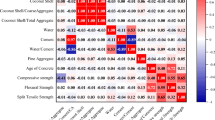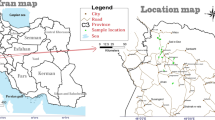Abstract
Rocks used as construction aggregate in temperate climates deteriorate to differing degrees because of repeated freezing and thawing. The magnitude of the deterioration depends on the rock's properties. Aggregate, including crushed carbonate rock, is required to have minimum geotechnical qualities before it can be used in asphalt and concrete. In order to reduce chances of premature and expensive repairs, extensive freeze-thaw tests are conducted on potential construction rocks. These tests typically involve 300 freeze-thaw cycles and can take four to five months to complete. Less time consuming tests that (1) predict durability as well as the extended freeze-thaw test or that (2) reduce the number of rocks subject to the extended test, could save considerable amounts of money. Here we use a probabilistic neural network to try and predict durability as determined by the freeze-thaw test using four rock properties measured on 843 limestone samples from the Kansas Department of Transportation. Modified freeze-thaw tests and less time consuming specific gravity (dry), specific gravity (saturated), and modified absorption tests were conducted on each sample. Durability factors of 95 or more as determined from the extensive freeze-thaw tests are viewed as acceptable—rocks with values below 95 are rejected. If only the modified freeze-thaw test is used to predict which rocks are acceptable, about 45% are misclassified. When 421 randomly selected samples and all four standardized and scaled variables were used to train aprobabilistic neural network, the rate of misclassification of 422 independent validation samples dropped to 28%. The network was trained so that each class (group) and each variable had its own coefficient (sigma). In an attempt to reduce errors further, an additional class was added to the training data to predict durability values greater than 84 and less than 98, resulting in only 11% of the samples misclassified. About 43% of the test data was classed by the neural net into the middle group—these rocks should be subject to full freeze-thaw tests. Thus, use of the probabilistic neural network would meanthat the extended test would only need be applied to 43% of the samples, and 11% of the rocks classed as acceptable would fail early.
Similar content being viewed by others
REFERENCES
Bliss, J. D., 1999, Quantitative models for aggregate: some types and examples from Oklahoma carbonate rocks, in Johnson, K. S., ed., Proc. 34th forum on the geology of industrial minerals, 1998: Oklahoma Geol. Survey Cir. 102, p. 37–45.
Bliss, J. D., and Singer, D. A., 2001, Can probabilistic neural networks be used to successfully classify carbonate aggregate? (abst.), in Simandl, G. J., Holland, J., Dunlop, S., and Rotella, M., compilers, 2001 Industrial minerals in Canada: Program and extended abstracts for the 37th Forum on the Geology of Industrial Minerals (Victoria, B. C.), p. 169–170.
Goh, A. T. C., 2002, Probabilistic neural network for evaluating seismic liquefaction potential: Can. Geotech. Jour., v.39, no.1, p. 219–232.
Langer, W. H., and Glanzman, V. M., 1993, Natural aggregate—building America's future: U.S. Geol. Survey Circ. 1110, 39p.
Marek, C. R., 1991, Basic properties of aggregate, in Barksdale, R. D., ed., The aggregate handbook: National Stone Association, Washington, p. 3–1 to 3–18.
Masters, T., 1993, Practical neural network recipes in C++: Academic Press, Inc., New York, 493p.
Masters, T., 1995, Advanced algorithms for neural networks: a C++ sourcebook: John Wiley & Sons, New York, 431p.
Najjar, Y. M., and Basheer, I. A., 1997, Modeling the durability of aggregate used in concrete pavement construction—a neuro-reliability-based approach: Kansas Department Transportation Rept. No. KS–97–3, 37p.
Singer, D. A., and Kouda, R., 1997, Classification of mineral deposits into types using mineralogy with a probabilistic neural network: Nonrenewable Resources, v.6, no.1, p. 27–32.
Singer, D. A., and Kouda, R., 2003, Typing mineral deposits using their grades and tonnages in an artificial neural network: Natural Resources Research, v.12, no.3, press.
Specht, D., 1990, Probabilistic neural networks: Neural Networks, v.3, no.2, p. 109–118.
Author information
Authors and Affiliations
Rights and permissions
About this article
Cite this article
Singer, D.A., Bliss, J.D. Use of a Probabilistic Neural Network to Reduce Costs of Selecting Construction Rock. Natural Resources Research 12, 135–140 (2003). https://doi.org/10.1023/A:1024266829365
Issue Date:
DOI: https://doi.org/10.1023/A:1024266829365




